Strategic Leadership Report: Leadership and Change in HSBC - Analysis
VerifiedAdded on 2023/01/12
|18
|5771
|21
Report
AI Summary
This report provides an in-depth analysis of strategic leadership, focusing on its application in change management within the context of HSBC, a multinational banking and financial services company. It explores various leadership models, including transformational leadership and Kotter's change management model, and discusses leadership styles relevant to the banking industry during periods of change, particularly in relation to globalization and internationalization. The report examines the leadership capabilities of key business leaders and evaluates the use of performance metrics, such as the balanced scorecard, to successfully implement change. The analysis considers contemporary research on the role and importance of leadership, assessing the relevance of different leadership styles to key changes in the banking sector. Furthermore, the report incorporates models like Hofstede’s cultural dimensions to understand international markets, providing insights into how leaders can adapt to diverse cultural contexts. Ultimately, the report aims to provide a comprehensive understanding of how effective leadership is crucial for organizational success and adaptation in the dynamic banking environment, using HSBC as a primary case study.
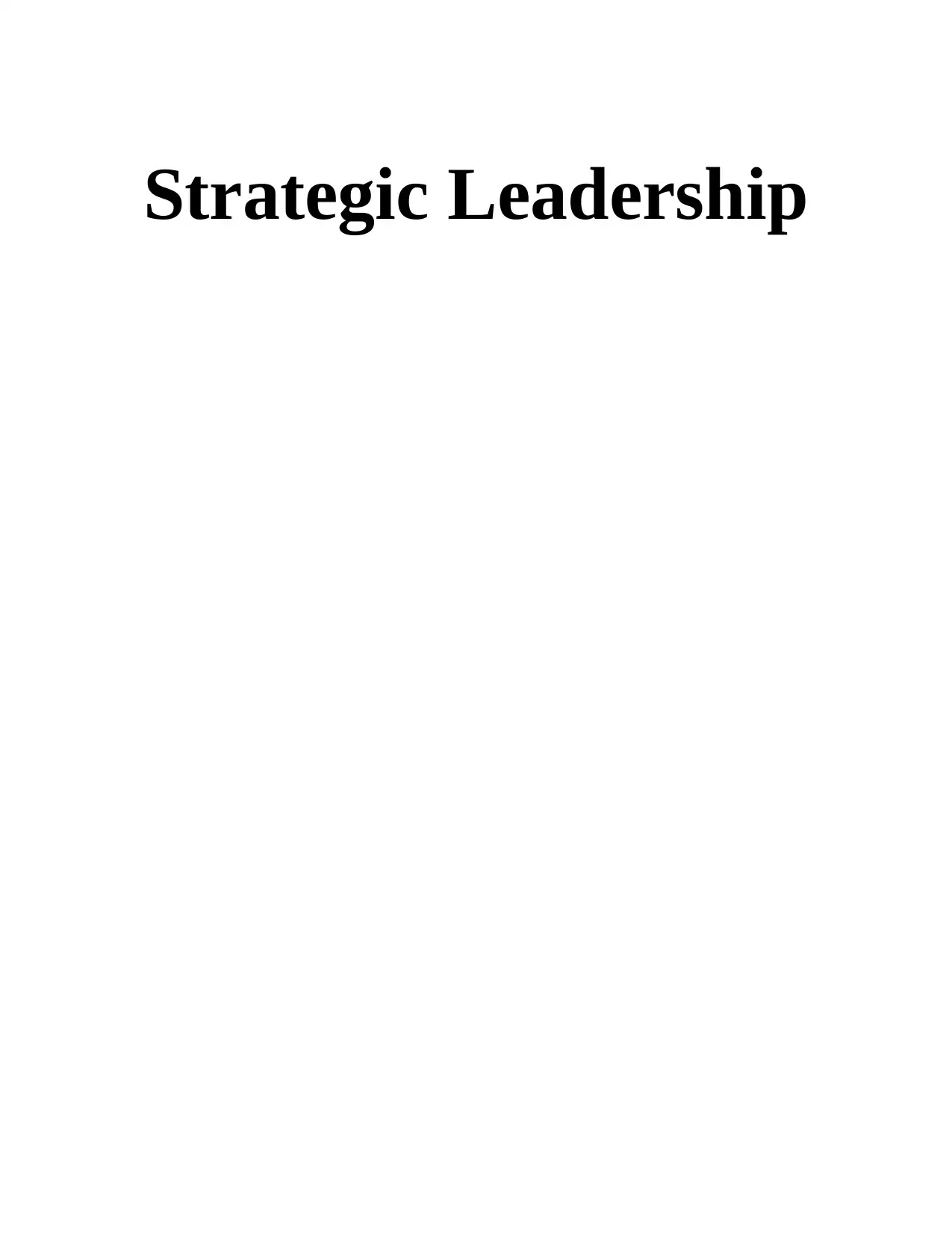
Strategic Leadership
Paraphrase This Document
Need a fresh take? Get an instant paraphrase of this document with our AI Paraphraser
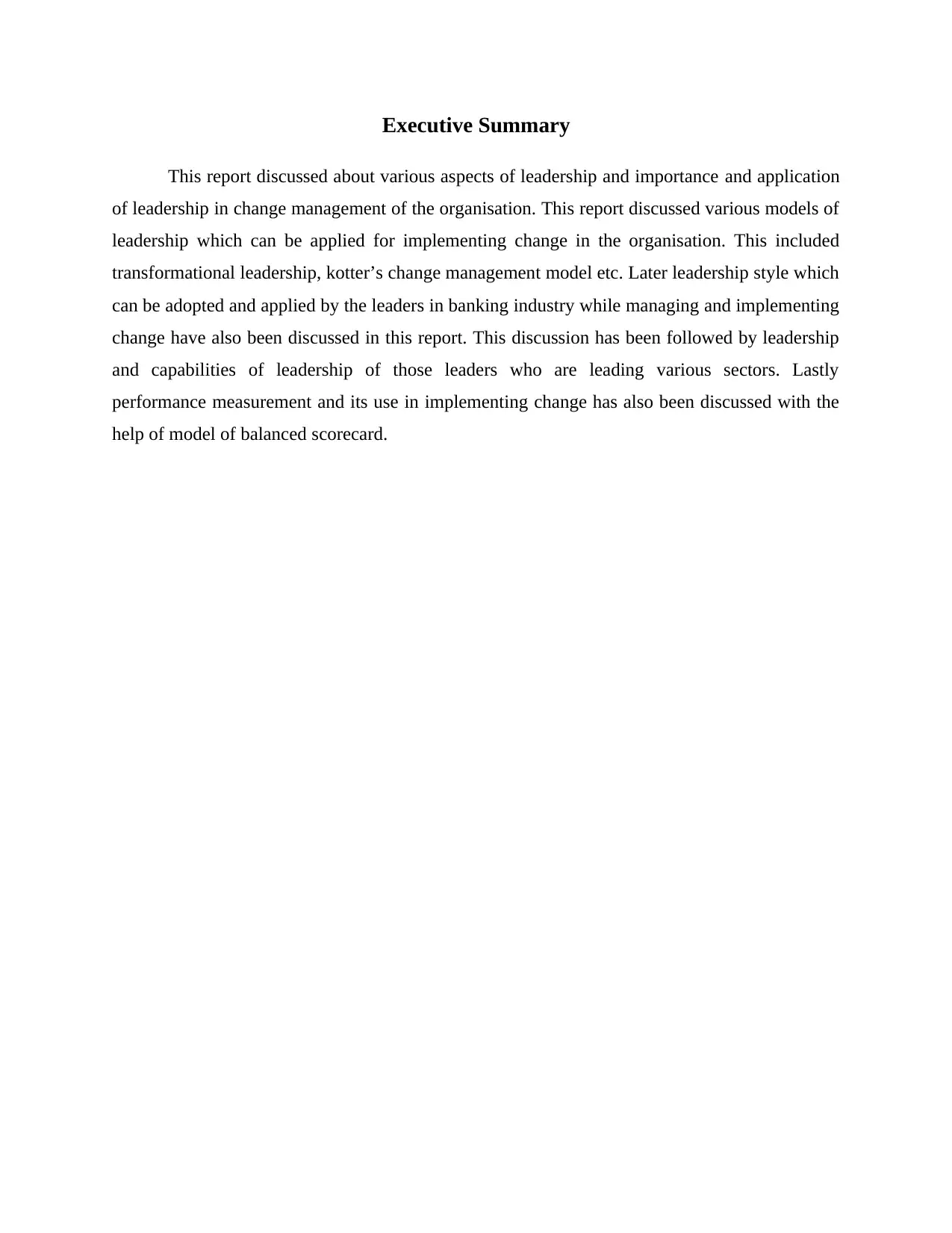
Executive Summary
This report discussed about various aspects of leadership and importance and application
of leadership in change management of the organisation. This report discussed various models of
leadership which can be applied for implementing change in the organisation. This included
transformational leadership, kotter’s change management model etc. Later leadership style which
can be adopted and applied by the leaders in banking industry while managing and implementing
change have also been discussed in this report. This discussion has been followed by leadership
and capabilities of leadership of those leaders who are leading various sectors. Lastly
performance measurement and its use in implementing change has also been discussed with the
help of model of balanced scorecard.
This report discussed about various aspects of leadership and importance and application
of leadership in change management of the organisation. This report discussed various models of
leadership which can be applied for implementing change in the organisation. This included
transformational leadership, kotter’s change management model etc. Later leadership style which
can be adopted and applied by the leaders in banking industry while managing and implementing
change have also been discussed in this report. This discussion has been followed by leadership
and capabilities of leadership of those leaders who are leading various sectors. Lastly
performance measurement and its use in implementing change has also been discussed with the
help of model of balanced scorecard.
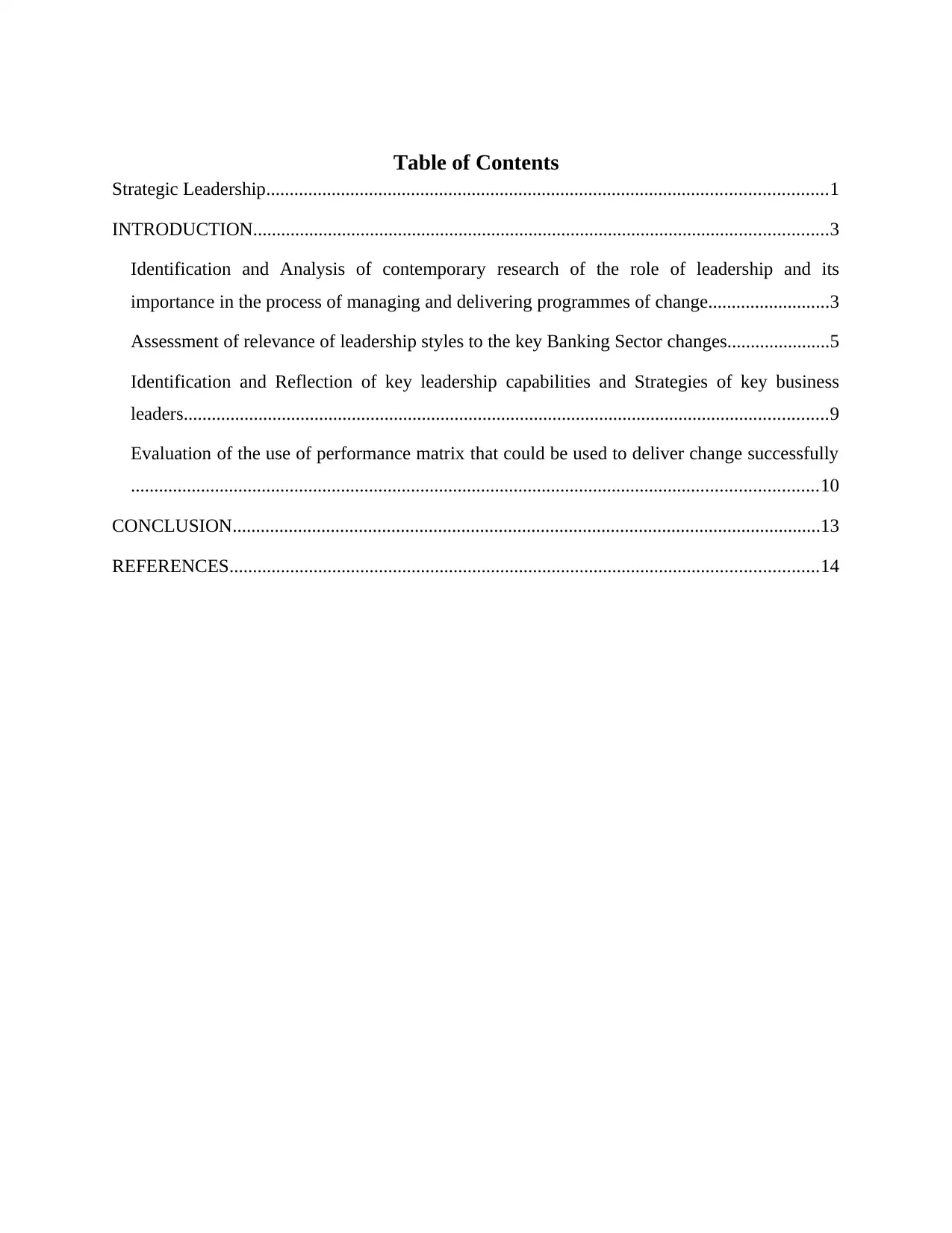
Table of Contents
Strategic Leadership........................................................................................................................1
INTRODUCTION...........................................................................................................................3
Identification and Analysis of contemporary research of the role of leadership and its
importance in the process of managing and delivering programmes of change..........................3
Assessment of relevance of leadership styles to the key Banking Sector changes......................5
Identification and Reflection of key leadership capabilities and Strategies of key business
leaders..........................................................................................................................................9
Evaluation of the use of performance matrix that could be used to deliver change successfully
...................................................................................................................................................10
CONCLUSION..............................................................................................................................13
REFERENCES..............................................................................................................................14
Strategic Leadership........................................................................................................................1
INTRODUCTION...........................................................................................................................3
Identification and Analysis of contemporary research of the role of leadership and its
importance in the process of managing and delivering programmes of change..........................3
Assessment of relevance of leadership styles to the key Banking Sector changes......................5
Identification and Reflection of key leadership capabilities and Strategies of key business
leaders..........................................................................................................................................9
Evaluation of the use of performance matrix that could be used to deliver change successfully
...................................................................................................................................................10
CONCLUSION..............................................................................................................................13
REFERENCES..............................................................................................................................14
⊘ This is a preview!⊘
Do you want full access?
Subscribe today to unlock all pages.

Trusted by 1+ million students worldwide
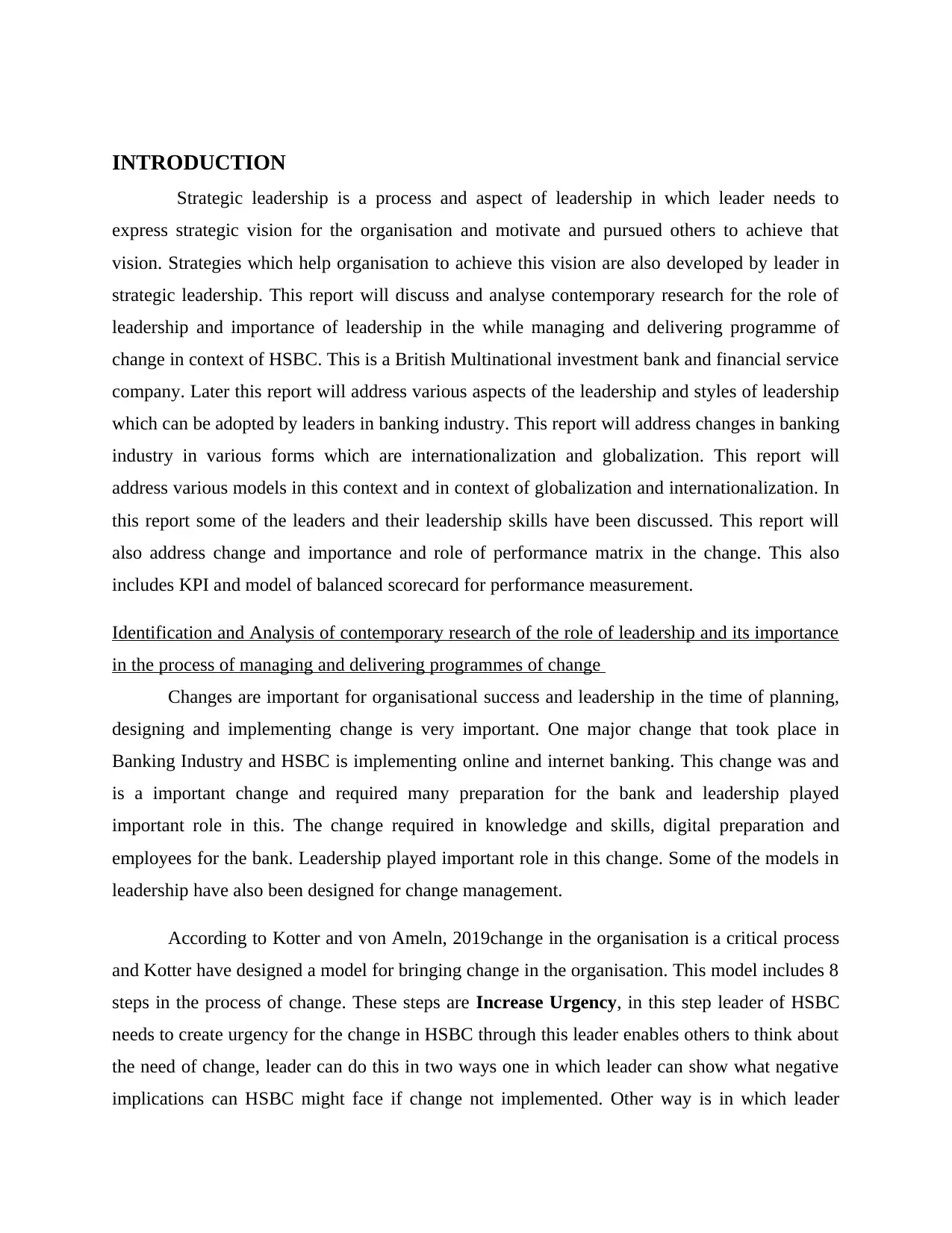
INTRODUCTION
Strategic leadership is a process and aspect of leadership in which leader needs to
express strategic vision for the organisation and motivate and pursued others to achieve that
vision. Strategies which help organisation to achieve this vision are also developed by leader in
strategic leadership. This report will discuss and analyse contemporary research for the role of
leadership and importance of leadership in the while managing and delivering programme of
change in context of HSBC. This is a British Multinational investment bank and financial service
company. Later this report will address various aspects of the leadership and styles of leadership
which can be adopted by leaders in banking industry. This report will address changes in banking
industry in various forms which are internationalization and globalization. This report will
address various models in this context and in context of globalization and internationalization. In
this report some of the leaders and their leadership skills have been discussed. This report will
also address change and importance and role of performance matrix in the change. This also
includes KPI and model of balanced scorecard for performance measurement.
Identification and Analysis of contemporary research of the role of leadership and its importance
in the process of managing and delivering programmes of change
Changes are important for organisational success and leadership in the time of planning,
designing and implementing change is very important. One major change that took place in
Banking Industry and HSBC is implementing online and internet banking. This change was and
is a important change and required many preparation for the bank and leadership played
important role in this. The change required in knowledge and skills, digital preparation and
employees for the bank. Leadership played important role in this change. Some of the models in
leadership have also been designed for change management.
According to Kotter and von Ameln, 2019change in the organisation is a critical process
and Kotter have designed a model for bringing change in the organisation. This model includes 8
steps in the process of change. These steps are Increase Urgency, in this step leader of HSBC
needs to create urgency for the change in HSBC through this leader enables others to think about
the need of change, leader can do this in two ways one in which leader can show what negative
implications can HSBC might face if change not implemented. Other way is in which leader
Strategic leadership is a process and aspect of leadership in which leader needs to
express strategic vision for the organisation and motivate and pursued others to achieve that
vision. Strategies which help organisation to achieve this vision are also developed by leader in
strategic leadership. This report will discuss and analyse contemporary research for the role of
leadership and importance of leadership in the while managing and delivering programme of
change in context of HSBC. This is a British Multinational investment bank and financial service
company. Later this report will address various aspects of the leadership and styles of leadership
which can be adopted by leaders in banking industry. This report will address changes in banking
industry in various forms which are internationalization and globalization. This report will
address various models in this context and in context of globalization and internationalization. In
this report some of the leaders and their leadership skills have been discussed. This report will
also address change and importance and role of performance matrix in the change. This also
includes KPI and model of balanced scorecard for performance measurement.
Identification and Analysis of contemporary research of the role of leadership and its importance
in the process of managing and delivering programmes of change
Changes are important for organisational success and leadership in the time of planning,
designing and implementing change is very important. One major change that took place in
Banking Industry and HSBC is implementing online and internet banking. This change was and
is a important change and required many preparation for the bank and leadership played
important role in this. The change required in knowledge and skills, digital preparation and
employees for the bank. Leadership played important role in this change. Some of the models in
leadership have also been designed for change management.
According to Kotter and von Ameln, 2019change in the organisation is a critical process
and Kotter have designed a model for bringing change in the organisation. This model includes 8
steps in the process of change. These steps are Increase Urgency, in this step leader of HSBC
needs to create urgency for the change in HSBC through this leader enables others to think about
the need of change, leader can do this in two ways one in which leader can show what negative
implications can HSBC might face if change not implemented. Other way is in which leader
Paraphrase This Document
Need a fresh take? Get an instant paraphrase of this document with our AI Paraphraser
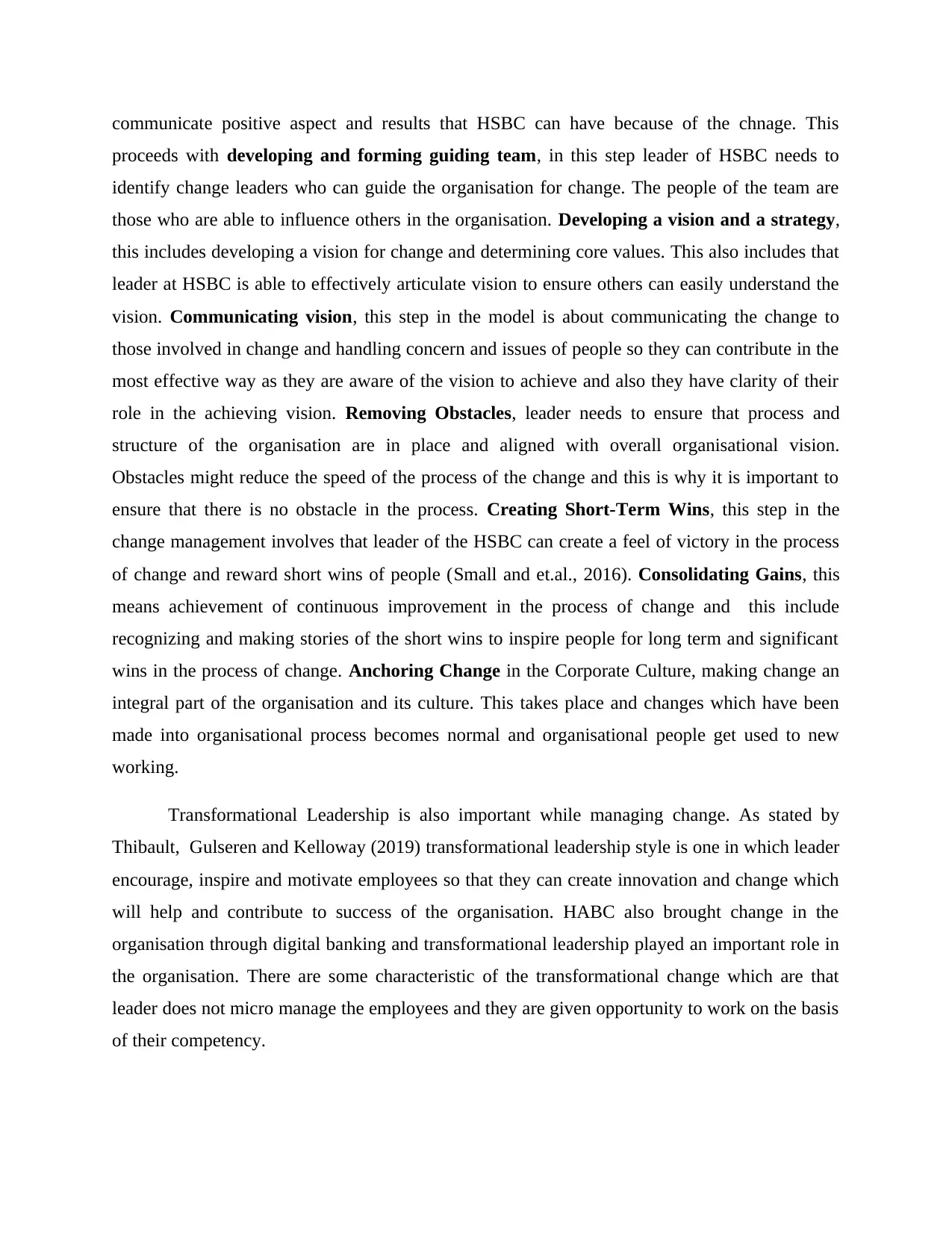
communicate positive aspect and results that HSBC can have because of the chnage. This
proceeds with developing and forming guiding team, in this step leader of HSBC needs to
identify change leaders who can guide the organisation for change. The people of the team are
those who are able to influence others in the organisation. Developing a vision and a strategy,
this includes developing a vision for change and determining core values. This also includes that
leader at HSBC is able to effectively articulate vision to ensure others can easily understand the
vision. Communicating vision, this step in the model is about communicating the change to
those involved in change and handling concern and issues of people so they can contribute in the
most effective way as they are aware of the vision to achieve and also they have clarity of their
role in the achieving vision. Removing Obstacles, leader needs to ensure that process and
structure of the organisation are in place and aligned with overall organisational vision.
Obstacles might reduce the speed of the process of the change and this is why it is important to
ensure that there is no obstacle in the process. Creating Short-Term Wins, this step in the
change management involves that leader of the HSBC can create a feel of victory in the process
of change and reward short wins of people (Small and et.al., 2016). Consolidating Gains, this
means achievement of continuous improvement in the process of change and this include
recognizing and making stories of the short wins to inspire people for long term and significant
wins in the process of change. Anchoring Change in the Corporate Culture, making change an
integral part of the organisation and its culture. This takes place and changes which have been
made into organisational process becomes normal and organisational people get used to new
working.
Transformational Leadership is also important while managing change. As stated by
Thibault, Gulseren and Kelloway (2019) transformational leadership style is one in which leader
encourage, inspire and motivate employees so that they can create innovation and change which
will help and contribute to success of the organisation. HABC also brought change in the
organisation through digital banking and transformational leadership played an important role in
the organisation. There are some characteristic of the transformational change which are that
leader does not micro manage the employees and they are given opportunity to work on the basis
of their competency.
proceeds with developing and forming guiding team, in this step leader of HSBC needs to
identify change leaders who can guide the organisation for change. The people of the team are
those who are able to influence others in the organisation. Developing a vision and a strategy,
this includes developing a vision for change and determining core values. This also includes that
leader at HSBC is able to effectively articulate vision to ensure others can easily understand the
vision. Communicating vision, this step in the model is about communicating the change to
those involved in change and handling concern and issues of people so they can contribute in the
most effective way as they are aware of the vision to achieve and also they have clarity of their
role in the achieving vision. Removing Obstacles, leader needs to ensure that process and
structure of the organisation are in place and aligned with overall organisational vision.
Obstacles might reduce the speed of the process of the change and this is why it is important to
ensure that there is no obstacle in the process. Creating Short-Term Wins, this step in the
change management involves that leader of the HSBC can create a feel of victory in the process
of change and reward short wins of people (Small and et.al., 2016). Consolidating Gains, this
means achievement of continuous improvement in the process of change and this include
recognizing and making stories of the short wins to inspire people for long term and significant
wins in the process of change. Anchoring Change in the Corporate Culture, making change an
integral part of the organisation and its culture. This takes place and changes which have been
made into organisational process becomes normal and organisational people get used to new
working.
Transformational Leadership is also important while managing change. As stated by
Thibault, Gulseren and Kelloway (2019) transformational leadership style is one in which leader
encourage, inspire and motivate employees so that they can create innovation and change which
will help and contribute to success of the organisation. HABC also brought change in the
organisation through digital banking and transformational leadership played an important role in
the organisation. There are some characteristic of the transformational change which are that
leader does not micro manage the employees and they are given opportunity to work on the basis
of their competency.
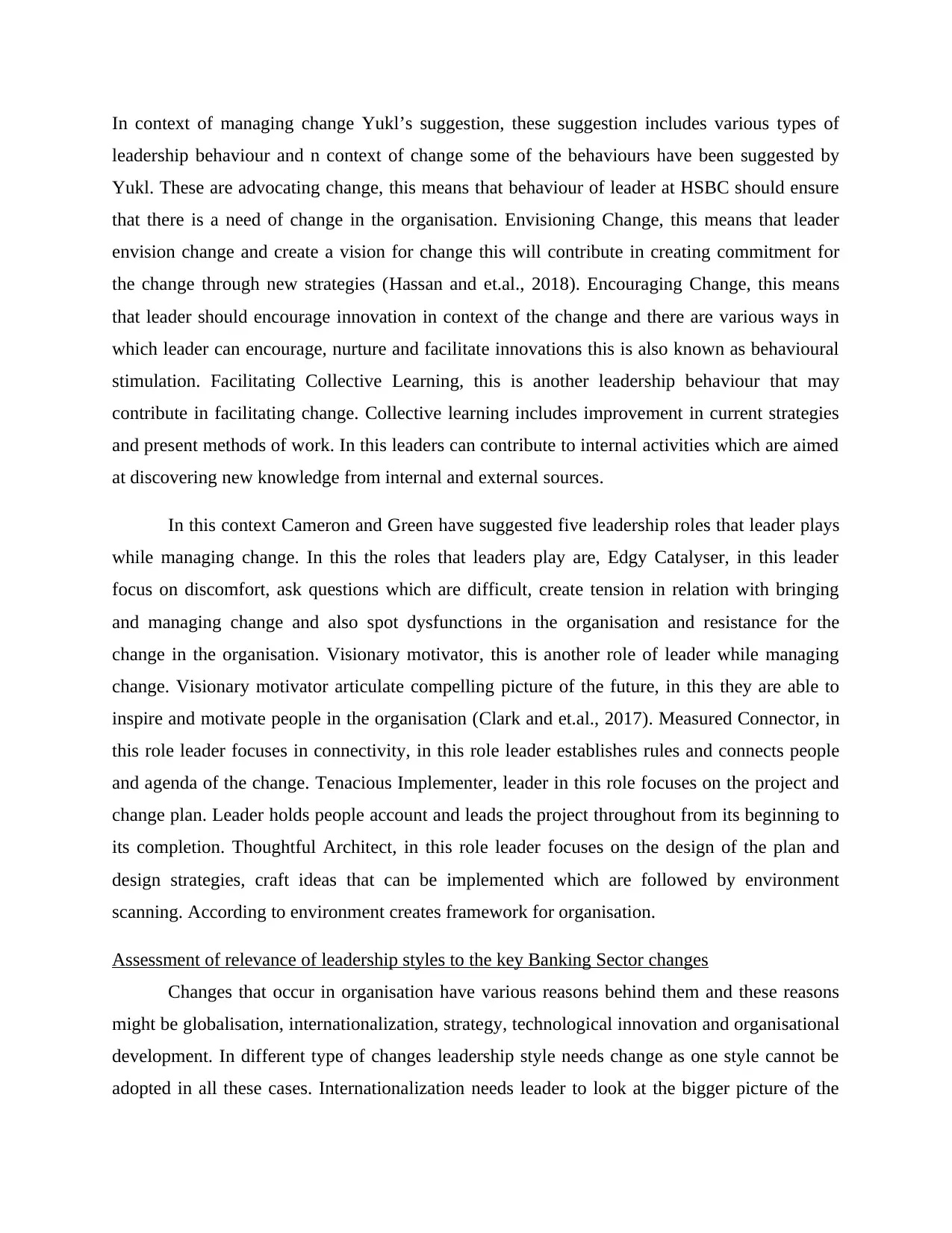
In context of managing change Yukl’s suggestion, these suggestion includes various types of
leadership behaviour and n context of change some of the behaviours have been suggested by
Yukl. These are advocating change, this means that behaviour of leader at HSBC should ensure
that there is a need of change in the organisation. Envisioning Change, this means that leader
envision change and create a vision for change this will contribute in creating commitment for
the change through new strategies (Hassan and et.al., 2018). Encouraging Change, this means
that leader should encourage innovation in context of the change and there are various ways in
which leader can encourage, nurture and facilitate innovations this is also known as behavioural
stimulation. Facilitating Collective Learning, this is another leadership behaviour that may
contribute in facilitating change. Collective learning includes improvement in current strategies
and present methods of work. In this leaders can contribute to internal activities which are aimed
at discovering new knowledge from internal and external sources.
In this context Cameron and Green have suggested five leadership roles that leader plays
while managing change. In this the roles that leaders play are, Edgy Catalyser, in this leader
focus on discomfort, ask questions which are difficult, create tension in relation with bringing
and managing change and also spot dysfunctions in the organisation and resistance for the
change in the organisation. Visionary motivator, this is another role of leader while managing
change. Visionary motivator articulate compelling picture of the future, in this they are able to
inspire and motivate people in the organisation (Clark and et.al., 2017). Measured Connector, in
this role leader focuses in connectivity, in this role leader establishes rules and connects people
and agenda of the change. Tenacious Implementer, leader in this role focuses on the project and
change plan. Leader holds people account and leads the project throughout from its beginning to
its completion. Thoughtful Architect, in this role leader focuses on the design of the plan and
design strategies, craft ideas that can be implemented which are followed by environment
scanning. According to environment creates framework for organisation.
Assessment of relevance of leadership styles to the key Banking Sector changes
Changes that occur in organisation have various reasons behind them and these reasons
might be globalisation, internationalization, strategy, technological innovation and organisational
development. In different type of changes leadership style needs change as one style cannot be
adopted in all these cases. Internationalization needs leader to look at the bigger picture of the
leadership behaviour and n context of change some of the behaviours have been suggested by
Yukl. These are advocating change, this means that behaviour of leader at HSBC should ensure
that there is a need of change in the organisation. Envisioning Change, this means that leader
envision change and create a vision for change this will contribute in creating commitment for
the change through new strategies (Hassan and et.al., 2018). Encouraging Change, this means
that leader should encourage innovation in context of the change and there are various ways in
which leader can encourage, nurture and facilitate innovations this is also known as behavioural
stimulation. Facilitating Collective Learning, this is another leadership behaviour that may
contribute in facilitating change. Collective learning includes improvement in current strategies
and present methods of work. In this leaders can contribute to internal activities which are aimed
at discovering new knowledge from internal and external sources.
In this context Cameron and Green have suggested five leadership roles that leader plays
while managing change. In this the roles that leaders play are, Edgy Catalyser, in this leader
focus on discomfort, ask questions which are difficult, create tension in relation with bringing
and managing change and also spot dysfunctions in the organisation and resistance for the
change in the organisation. Visionary motivator, this is another role of leader while managing
change. Visionary motivator articulate compelling picture of the future, in this they are able to
inspire and motivate people in the organisation (Clark and et.al., 2017). Measured Connector, in
this role leader focuses in connectivity, in this role leader establishes rules and connects people
and agenda of the change. Tenacious Implementer, leader in this role focuses on the project and
change plan. Leader holds people account and leads the project throughout from its beginning to
its completion. Thoughtful Architect, in this role leader focuses on the design of the plan and
design strategies, craft ideas that can be implemented which are followed by environment
scanning. According to environment creates framework for organisation.
Assessment of relevance of leadership styles to the key Banking Sector changes
Changes that occur in organisation have various reasons behind them and these reasons
might be globalisation, internationalization, strategy, technological innovation and organisational
development. In different type of changes leadership style needs change as one style cannot be
adopted in all these cases. Internationalization needs leader to look at the bigger picture of the
⊘ This is a preview!⊘
Do you want full access?
Subscribe today to unlock all pages.

Trusted by 1+ million students worldwide
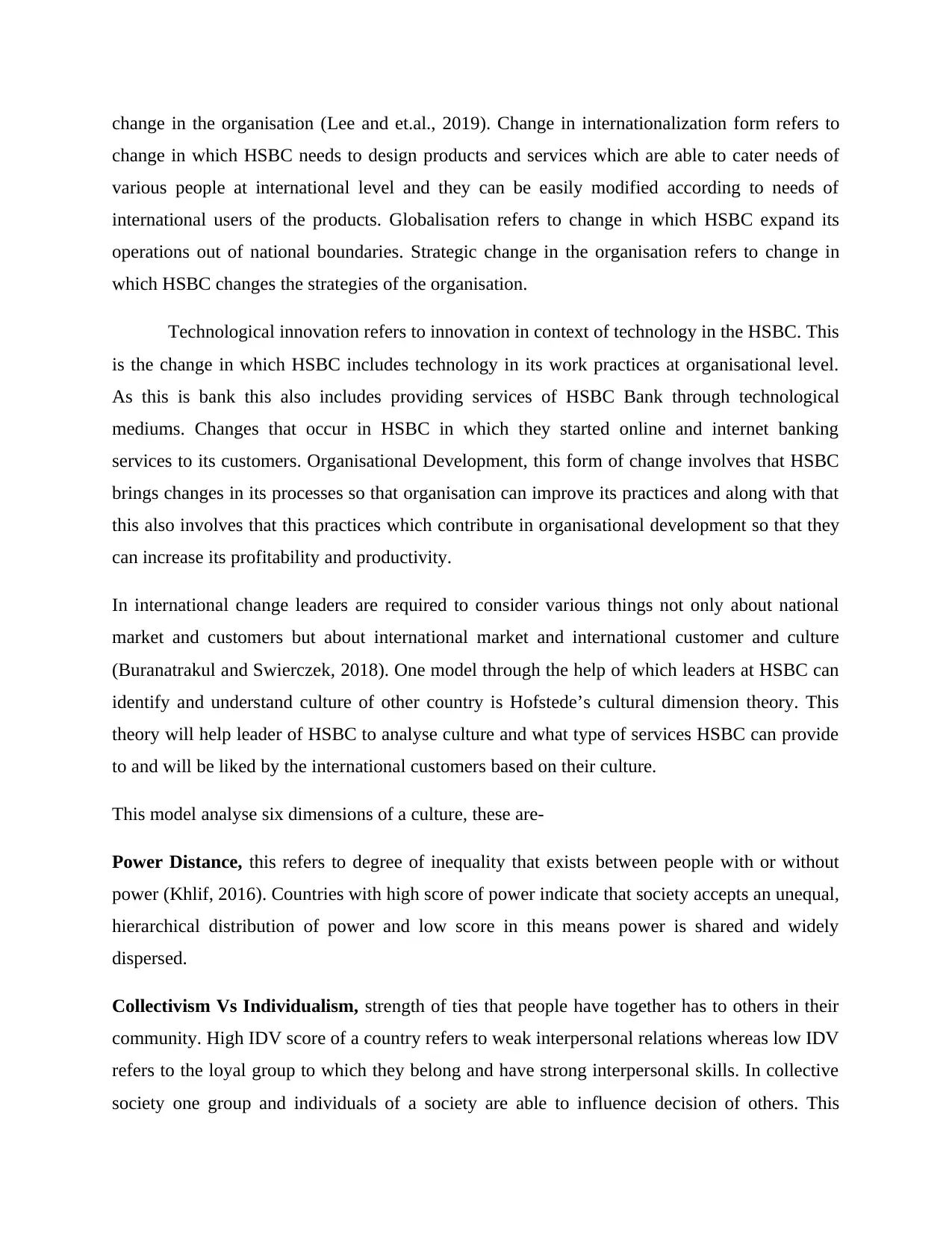
change in the organisation (Lee and et.al., 2019). Change in internationalization form refers to
change in which HSBC needs to design products and services which are able to cater needs of
various people at international level and they can be easily modified according to needs of
international users of the products. Globalisation refers to change in which HSBC expand its
operations out of national boundaries. Strategic change in the organisation refers to change in
which HSBC changes the strategies of the organisation.
Technological innovation refers to innovation in context of technology in the HSBC. This
is the change in which HSBC includes technology in its work practices at organisational level.
As this is bank this also includes providing services of HSBC Bank through technological
mediums. Changes that occur in HSBC in which they started online and internet banking
services to its customers. Organisational Development, this form of change involves that HSBC
brings changes in its processes so that organisation can improve its practices and along with that
this also involves that this practices which contribute in organisational development so that they
can increase its profitability and productivity.
In international change leaders are required to consider various things not only about national
market and customers but about international market and international customer and culture
(Buranatrakul and Swierczek, 2018). One model through the help of which leaders at HSBC can
identify and understand culture of other country is Hofstede’s cultural dimension theory. This
theory will help leader of HSBC to analyse culture and what type of services HSBC can provide
to and will be liked by the international customers based on their culture.
This model analyse six dimensions of a culture, these are-
Power Distance, this refers to degree of inequality that exists between people with or without
power (Khlif, 2016). Countries with high score of power indicate that society accepts an unequal,
hierarchical distribution of power and low score in this means power is shared and widely
dispersed.
Collectivism Vs Individualism, strength of ties that people have together has to others in their
community. High IDV score of a country refers to weak interpersonal relations whereas low IDV
refers to the loyal group to which they belong and have strong interpersonal skills. In collective
society one group and individuals of a society are able to influence decision of others. This
change in which HSBC needs to design products and services which are able to cater needs of
various people at international level and they can be easily modified according to needs of
international users of the products. Globalisation refers to change in which HSBC expand its
operations out of national boundaries. Strategic change in the organisation refers to change in
which HSBC changes the strategies of the organisation.
Technological innovation refers to innovation in context of technology in the HSBC. This
is the change in which HSBC includes technology in its work practices at organisational level.
As this is bank this also includes providing services of HSBC Bank through technological
mediums. Changes that occur in HSBC in which they started online and internet banking
services to its customers. Organisational Development, this form of change involves that HSBC
brings changes in its processes so that organisation can improve its practices and along with that
this also involves that this practices which contribute in organisational development so that they
can increase its profitability and productivity.
In international change leaders are required to consider various things not only about national
market and customers but about international market and international customer and culture
(Buranatrakul and Swierczek, 2018). One model through the help of which leaders at HSBC can
identify and understand culture of other country is Hofstede’s cultural dimension theory. This
theory will help leader of HSBC to analyse culture and what type of services HSBC can provide
to and will be liked by the international customers based on their culture.
This model analyse six dimensions of a culture, these are-
Power Distance, this refers to degree of inequality that exists between people with or without
power (Khlif, 2016). Countries with high score of power indicate that society accepts an unequal,
hierarchical distribution of power and low score in this means power is shared and widely
dispersed.
Collectivism Vs Individualism, strength of ties that people have together has to others in their
community. High IDV score of a country refers to weak interpersonal relations whereas low IDV
refers to the loyal group to which they belong and have strong interpersonal skills. In collective
society one group and individuals of a society are able to influence decision of others. This
Paraphrase This Document
Need a fresh take? Get an instant paraphrase of this document with our AI Paraphraser
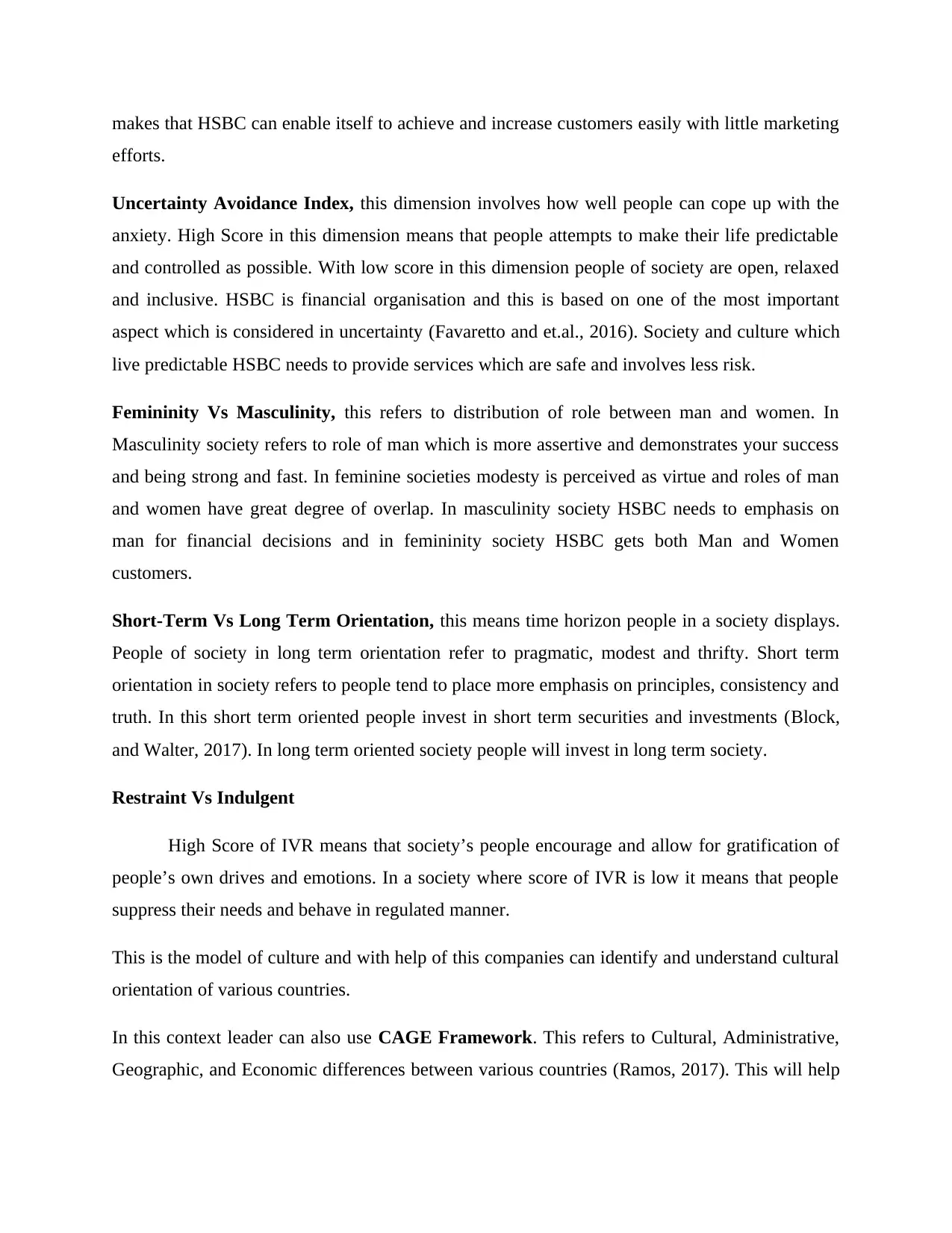
makes that HSBC can enable itself to achieve and increase customers easily with little marketing
efforts.
Uncertainty Avoidance Index, this dimension involves how well people can cope up with the
anxiety. High Score in this dimension means that people attempts to make their life predictable
and controlled as possible. With low score in this dimension people of society are open, relaxed
and inclusive. HSBC is financial organisation and this is based on one of the most important
aspect which is considered in uncertainty (Favaretto and et.al., 2016). Society and culture which
live predictable HSBC needs to provide services which are safe and involves less risk.
Femininity Vs Masculinity, this refers to distribution of role between man and women. In
Masculinity society refers to role of man which is more assertive and demonstrates your success
and being strong and fast. In feminine societies modesty is perceived as virtue and roles of man
and women have great degree of overlap. In masculinity society HSBC needs to emphasis on
man for financial decisions and in femininity society HSBC gets both Man and Women
customers.
Short-Term Vs Long Term Orientation, this means time horizon people in a society displays.
People of society in long term orientation refer to pragmatic, modest and thrifty. Short term
orientation in society refers to people tend to place more emphasis on principles, consistency and
truth. In this short term oriented people invest in short term securities and investments (Block,
and Walter, 2017). In long term oriented society people will invest in long term society.
Restraint Vs Indulgent
High Score of IVR means that society’s people encourage and allow for gratification of
people’s own drives and emotions. In a society where score of IVR is low it means that people
suppress their needs and behave in regulated manner.
This is the model of culture and with help of this companies can identify and understand cultural
orientation of various countries.
In this context leader can also use CAGE Framework. This refers to Cultural, Administrative,
Geographic, and Economic differences between various countries (Ramos, 2017). This will help
efforts.
Uncertainty Avoidance Index, this dimension involves how well people can cope up with the
anxiety. High Score in this dimension means that people attempts to make their life predictable
and controlled as possible. With low score in this dimension people of society are open, relaxed
and inclusive. HSBC is financial organisation and this is based on one of the most important
aspect which is considered in uncertainty (Favaretto and et.al., 2016). Society and culture which
live predictable HSBC needs to provide services which are safe and involves less risk.
Femininity Vs Masculinity, this refers to distribution of role between man and women. In
Masculinity society refers to role of man which is more assertive and demonstrates your success
and being strong and fast. In feminine societies modesty is perceived as virtue and roles of man
and women have great degree of overlap. In masculinity society HSBC needs to emphasis on
man for financial decisions and in femininity society HSBC gets both Man and Women
customers.
Short-Term Vs Long Term Orientation, this means time horizon people in a society displays.
People of society in long term orientation refer to pragmatic, modest and thrifty. Short term
orientation in society refers to people tend to place more emphasis on principles, consistency and
truth. In this short term oriented people invest in short term securities and investments (Block,
and Walter, 2017). In long term oriented society people will invest in long term society.
Restraint Vs Indulgent
High Score of IVR means that society’s people encourage and allow for gratification of
people’s own drives and emotions. In a society where score of IVR is low it means that people
suppress their needs and behave in regulated manner.
This is the model of culture and with help of this companies can identify and understand cultural
orientation of various countries.
In this context leader can also use CAGE Framework. This refers to Cultural, Administrative,
Geographic, and Economic differences between various countries (Ramos, 2017). This will help
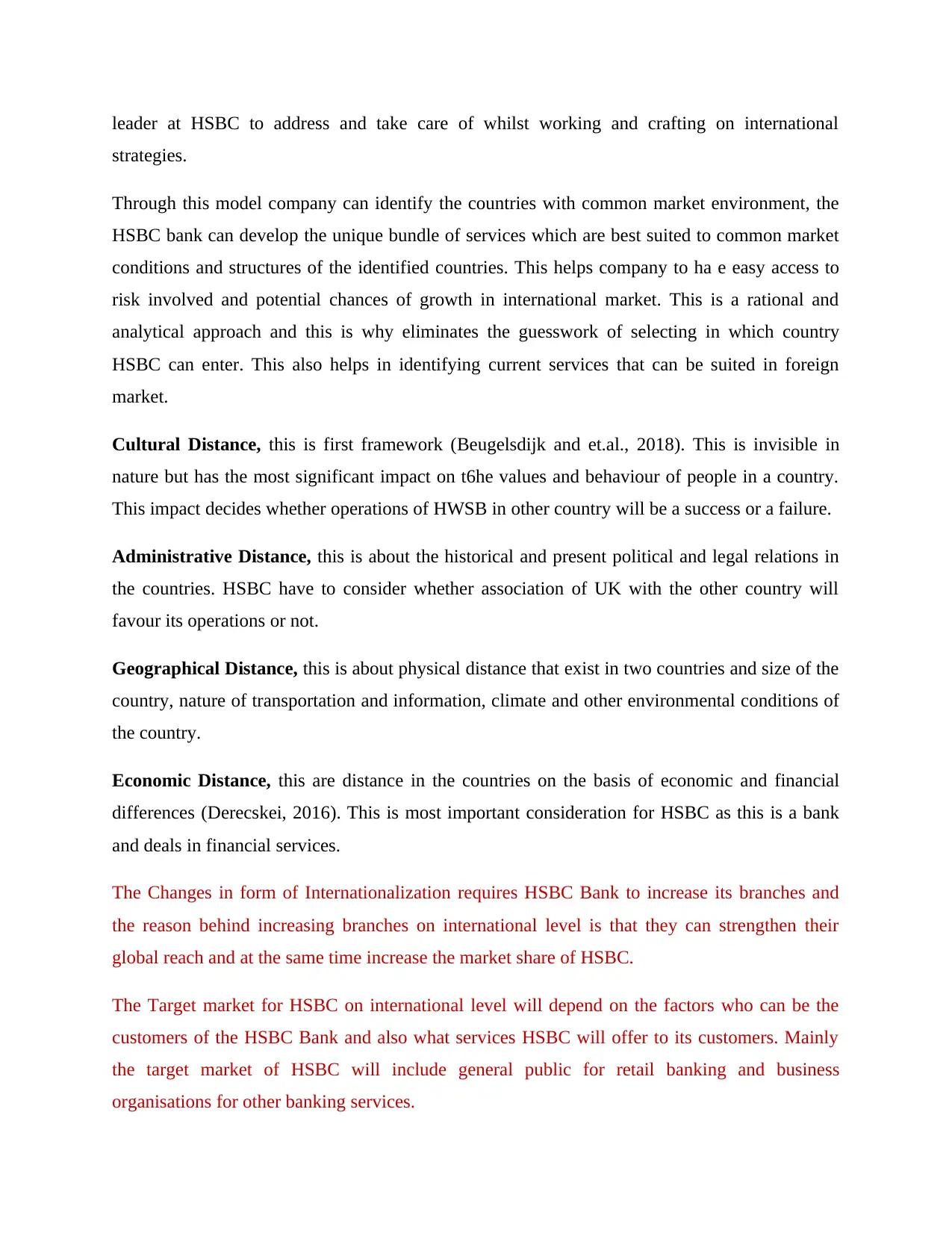
leader at HSBC to address and take care of whilst working and crafting on international
strategies.
Through this model company can identify the countries with common market environment, the
HSBC bank can develop the unique bundle of services which are best suited to common market
conditions and structures of the identified countries. This helps company to ha e easy access to
risk involved and potential chances of growth in international market. This is a rational and
analytical approach and this is why eliminates the guesswork of selecting in which country
HSBC can enter. This also helps in identifying current services that can be suited in foreign
market.
Cultural Distance, this is first framework (Beugelsdijk and et.al., 2018). This is invisible in
nature but has the most significant impact on t6he values and behaviour of people in a country.
This impact decides whether operations of HWSB in other country will be a success or a failure.
Administrative Distance, this is about the historical and present political and legal relations in
the countries. HSBC have to consider whether association of UK with the other country will
favour its operations or not.
Geographical Distance, this is about physical distance that exist in two countries and size of the
country, nature of transportation and information, climate and other environmental conditions of
the country.
Economic Distance, this are distance in the countries on the basis of economic and financial
differences (Derecskei, 2016). This is most important consideration for HSBC as this is a bank
and deals in financial services.
The Changes in form of Internationalization requires HSBC Bank to increase its branches and
the reason behind increasing branches on international level is that they can strengthen their
global reach and at the same time increase the market share of HSBC.
The Target market for HSBC on international level will depend on the factors who can be the
customers of the HSBC Bank and also what services HSBC will offer to its customers. Mainly
the target market of HSBC will include general public for retail banking and business
organisations for other banking services.
strategies.
Through this model company can identify the countries with common market environment, the
HSBC bank can develop the unique bundle of services which are best suited to common market
conditions and structures of the identified countries. This helps company to ha e easy access to
risk involved and potential chances of growth in international market. This is a rational and
analytical approach and this is why eliminates the guesswork of selecting in which country
HSBC can enter. This also helps in identifying current services that can be suited in foreign
market.
Cultural Distance, this is first framework (Beugelsdijk and et.al., 2018). This is invisible in
nature but has the most significant impact on t6he values and behaviour of people in a country.
This impact decides whether operations of HWSB in other country will be a success or a failure.
Administrative Distance, this is about the historical and present political and legal relations in
the countries. HSBC have to consider whether association of UK with the other country will
favour its operations or not.
Geographical Distance, this is about physical distance that exist in two countries and size of the
country, nature of transportation and information, climate and other environmental conditions of
the country.
Economic Distance, this are distance in the countries on the basis of economic and financial
differences (Derecskei, 2016). This is most important consideration for HSBC as this is a bank
and deals in financial services.
The Changes in form of Internationalization requires HSBC Bank to increase its branches and
the reason behind increasing branches on international level is that they can strengthen their
global reach and at the same time increase the market share of HSBC.
The Target market for HSBC on international level will depend on the factors who can be the
customers of the HSBC Bank and also what services HSBC will offer to its customers. Mainly
the target market of HSBC will include general public for retail banking and business
organisations for other banking services.
⊘ This is a preview!⊘
Do you want full access?
Subscribe today to unlock all pages.

Trusted by 1+ million students worldwide
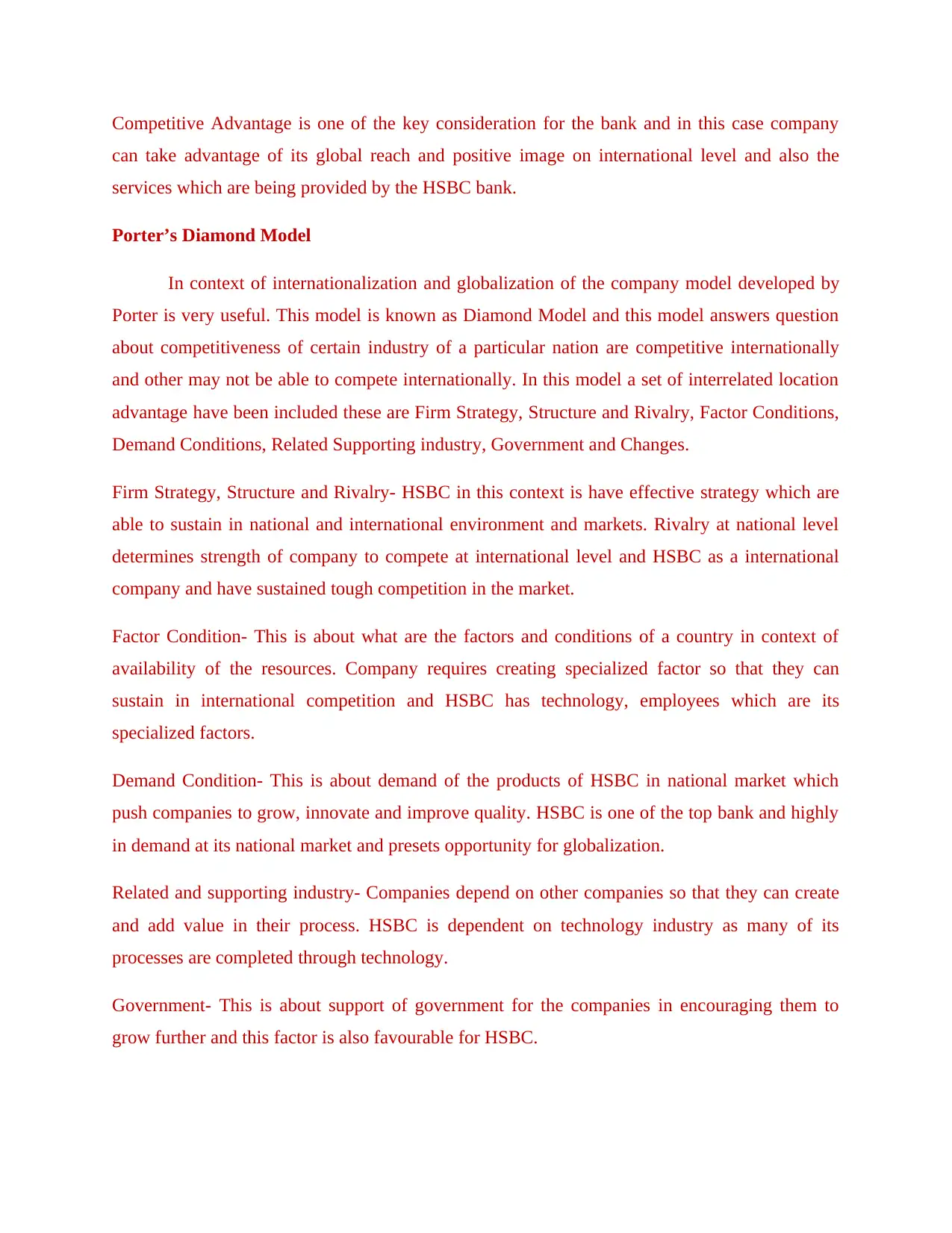
Competitive Advantage is one of the key consideration for the bank and in this case company
can take advantage of its global reach and positive image on international level and also the
services which are being provided by the HSBC bank.
Porter’s Diamond Model
In context of internationalization and globalization of the company model developed by
Porter is very useful. This model is known as Diamond Model and this model answers question
about competitiveness of certain industry of a particular nation are competitive internationally
and other may not be able to compete internationally. In this model a set of interrelated location
advantage have been included these are Firm Strategy, Structure and Rivalry, Factor Conditions,
Demand Conditions, Related Supporting industry, Government and Changes.
Firm Strategy, Structure and Rivalry- HSBC in this context is have effective strategy which are
able to sustain in national and international environment and markets. Rivalry at national level
determines strength of company to compete at international level and HSBC as a international
company and have sustained tough competition in the market.
Factor Condition- This is about what are the factors and conditions of a country in context of
availability of the resources. Company requires creating specialized factor so that they can
sustain in international competition and HSBC has technology, employees which are its
specialized factors.
Demand Condition- This is about demand of the products of HSBC in national market which
push companies to grow, innovate and improve quality. HSBC is one of the top bank and highly
in demand at its national market and presets opportunity for globalization.
Related and supporting industry- Companies depend on other companies so that they can create
and add value in their process. HSBC is dependent on technology industry as many of its
processes are completed through technology.
Government- This is about support of government for the companies in encouraging them to
grow further and this factor is also favourable for HSBC.
can take advantage of its global reach and positive image on international level and also the
services which are being provided by the HSBC bank.
Porter’s Diamond Model
In context of internationalization and globalization of the company model developed by
Porter is very useful. This model is known as Diamond Model and this model answers question
about competitiveness of certain industry of a particular nation are competitive internationally
and other may not be able to compete internationally. In this model a set of interrelated location
advantage have been included these are Firm Strategy, Structure and Rivalry, Factor Conditions,
Demand Conditions, Related Supporting industry, Government and Changes.
Firm Strategy, Structure and Rivalry- HSBC in this context is have effective strategy which are
able to sustain in national and international environment and markets. Rivalry at national level
determines strength of company to compete at international level and HSBC as a international
company and have sustained tough competition in the market.
Factor Condition- This is about what are the factors and conditions of a country in context of
availability of the resources. Company requires creating specialized factor so that they can
sustain in international competition and HSBC has technology, employees which are its
specialized factors.
Demand Condition- This is about demand of the products of HSBC in national market which
push companies to grow, innovate and improve quality. HSBC is one of the top bank and highly
in demand at its national market and presets opportunity for globalization.
Related and supporting industry- Companies depend on other companies so that they can create
and add value in their process. HSBC is dependent on technology industry as many of its
processes are completed through technology.
Government- This is about support of government for the companies in encouraging them to
grow further and this factor is also favourable for HSBC.
Paraphrase This Document
Need a fresh take? Get an instant paraphrase of this document with our AI Paraphraser
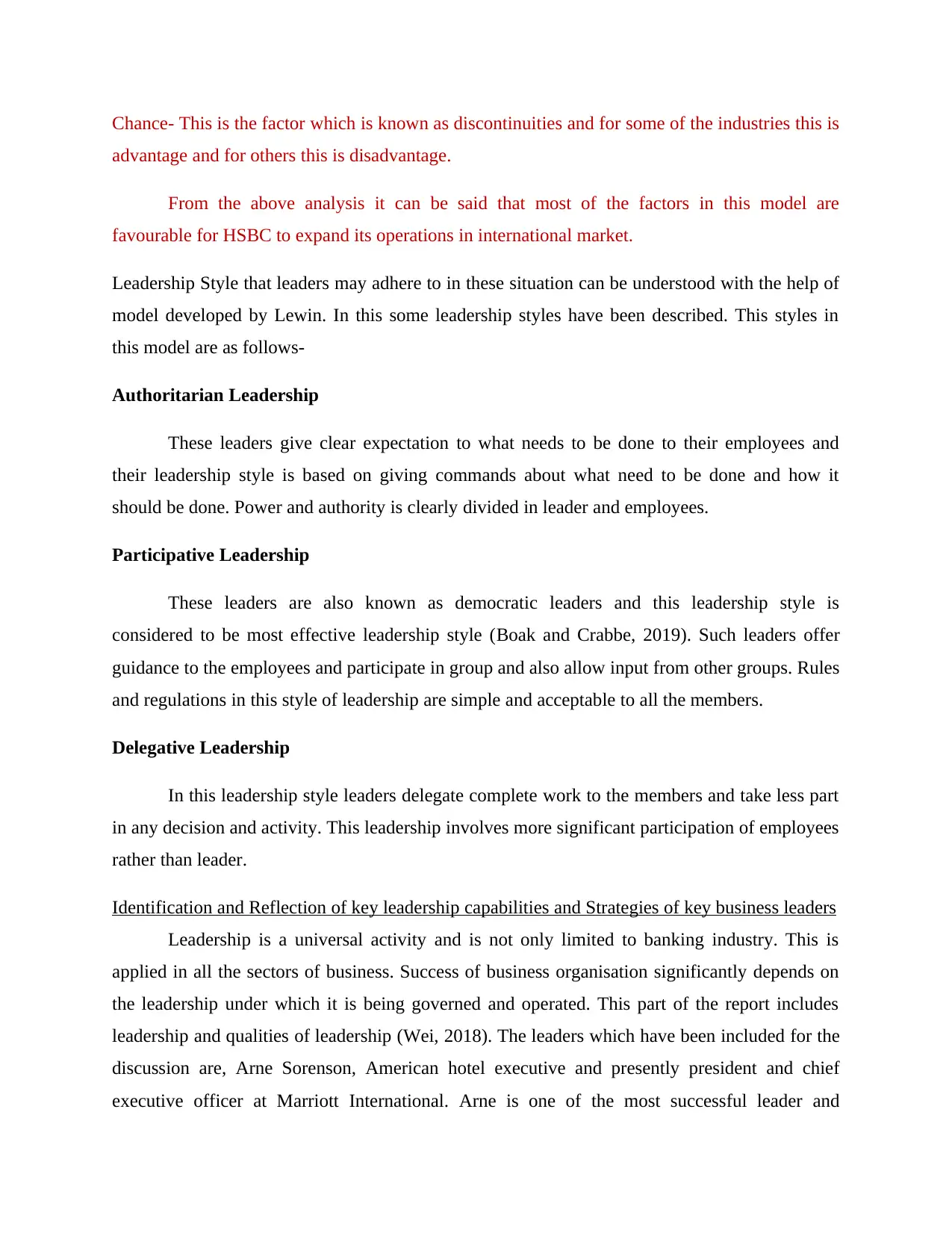
Chance- This is the factor which is known as discontinuities and for some of the industries this is
advantage and for others this is disadvantage.
From the above analysis it can be said that most of the factors in this model are
favourable for HSBC to expand its operations in international market.
Leadership Style that leaders may adhere to in these situation can be understood with the help of
model developed by Lewin. In this some leadership styles have been described. This styles in
this model are as follows-
Authoritarian Leadership
These leaders give clear expectation to what needs to be done to their employees and
their leadership style is based on giving commands about what need to be done and how it
should be done. Power and authority is clearly divided in leader and employees.
Participative Leadership
These leaders are also known as democratic leaders and this leadership style is
considered to be most effective leadership style (Boak and Crabbe, 2019). Such leaders offer
guidance to the employees and participate in group and also allow input from other groups. Rules
and regulations in this style of leadership are simple and acceptable to all the members.
Delegative Leadership
In this leadership style leaders delegate complete work to the members and take less part
in any decision and activity. This leadership involves more significant participation of employees
rather than leader.
Identification and Reflection of key leadership capabilities and Strategies of key business leaders
Leadership is a universal activity and is not only limited to banking industry. This is
applied in all the sectors of business. Success of business organisation significantly depends on
the leadership under which it is being governed and operated. This part of the report includes
leadership and qualities of leadership (Wei, 2018). The leaders which have been included for the
discussion are, Arne Sorenson, American hotel executive and presently president and chief
executive officer at Marriott International. Arne is one of the most successful leader and
advantage and for others this is disadvantage.
From the above analysis it can be said that most of the factors in this model are
favourable for HSBC to expand its operations in international market.
Leadership Style that leaders may adhere to in these situation can be understood with the help of
model developed by Lewin. In this some leadership styles have been described. This styles in
this model are as follows-
Authoritarian Leadership
These leaders give clear expectation to what needs to be done to their employees and
their leadership style is based on giving commands about what need to be done and how it
should be done. Power and authority is clearly divided in leader and employees.
Participative Leadership
These leaders are also known as democratic leaders and this leadership style is
considered to be most effective leadership style (Boak and Crabbe, 2019). Such leaders offer
guidance to the employees and participate in group and also allow input from other groups. Rules
and regulations in this style of leadership are simple and acceptable to all the members.
Delegative Leadership
In this leadership style leaders delegate complete work to the members and take less part
in any decision and activity. This leadership involves more significant participation of employees
rather than leader.
Identification and Reflection of key leadership capabilities and Strategies of key business leaders
Leadership is a universal activity and is not only limited to banking industry. This is
applied in all the sectors of business. Success of business organisation significantly depends on
the leadership under which it is being governed and operated. This part of the report includes
leadership and qualities of leadership (Wei, 2018). The leaders which have been included for the
discussion are, Arne Sorenson, American hotel executive and presently president and chief
executive officer at Marriott International. Arne is one of the most successful leader and
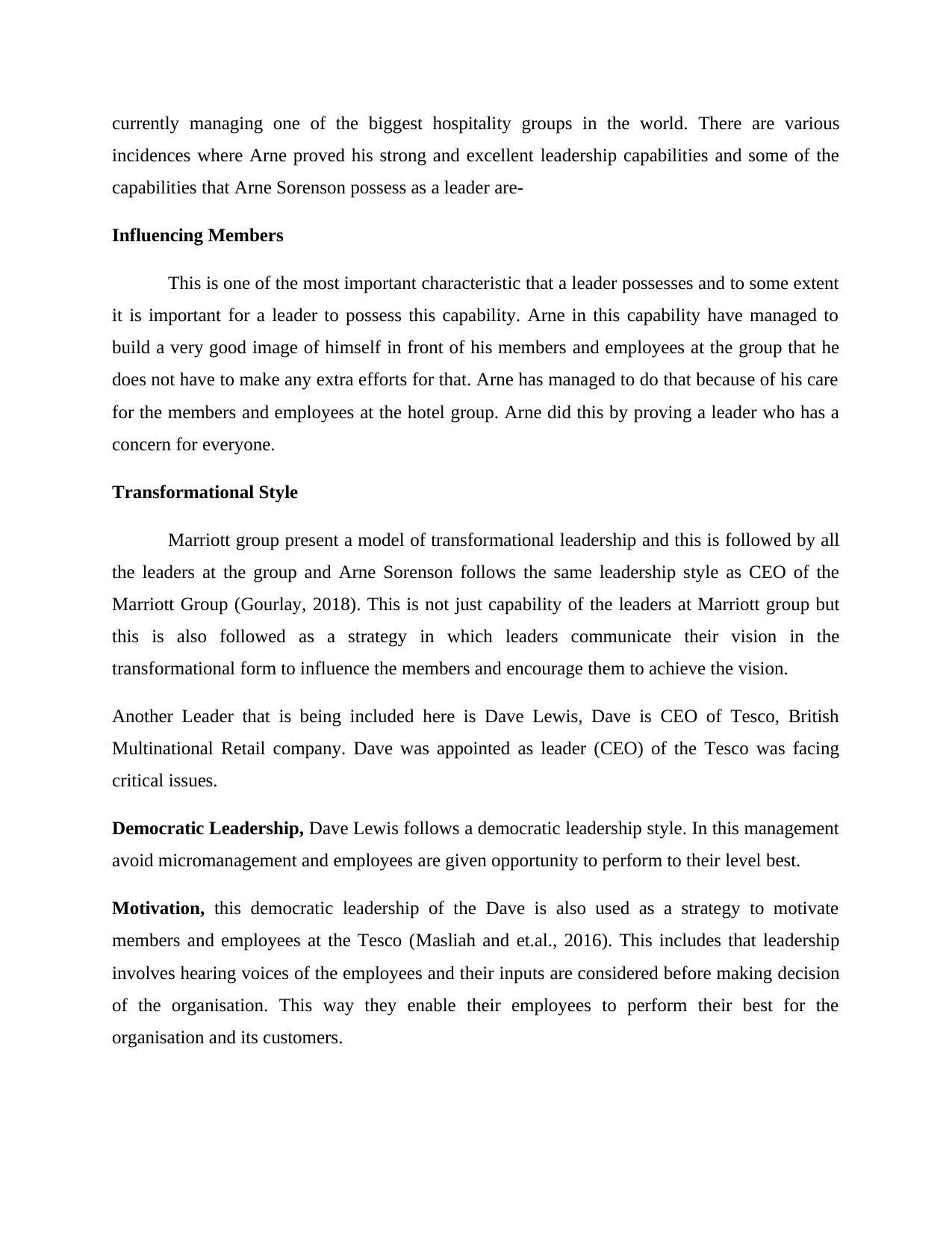
currently managing one of the biggest hospitality groups in the world. There are various
incidences where Arne proved his strong and excellent leadership capabilities and some of the
capabilities that Arne Sorenson possess as a leader are-
Influencing Members
This is one of the most important characteristic that a leader possesses and to some extent
it is important for a leader to possess this capability. Arne in this capability have managed to
build a very good image of himself in front of his members and employees at the group that he
does not have to make any extra efforts for that. Arne has managed to do that because of his care
for the members and employees at the hotel group. Arne did this by proving a leader who has a
concern for everyone.
Transformational Style
Marriott group present a model of transformational leadership and this is followed by all
the leaders at the group and Arne Sorenson follows the same leadership style as CEO of the
Marriott Group (Gourlay, 2018). This is not just capability of the leaders at Marriott group but
this is also followed as a strategy in which leaders communicate their vision in the
transformational form to influence the members and encourage them to achieve the vision.
Another Leader that is being included here is Dave Lewis, Dave is CEO of Tesco, British
Multinational Retail company. Dave was appointed as leader (CEO) of the Tesco was facing
critical issues.
Democratic Leadership, Dave Lewis follows a democratic leadership style. In this management
avoid micromanagement and employees are given opportunity to perform to their level best.
Motivation, this democratic leadership of the Dave is also used as a strategy to motivate
members and employees at the Tesco (Masliah and et.al., 2016). This includes that leadership
involves hearing voices of the employees and their inputs are considered before making decision
of the organisation. This way they enable their employees to perform their best for the
organisation and its customers.
incidences where Arne proved his strong and excellent leadership capabilities and some of the
capabilities that Arne Sorenson possess as a leader are-
Influencing Members
This is one of the most important characteristic that a leader possesses and to some extent
it is important for a leader to possess this capability. Arne in this capability have managed to
build a very good image of himself in front of his members and employees at the group that he
does not have to make any extra efforts for that. Arne has managed to do that because of his care
for the members and employees at the hotel group. Arne did this by proving a leader who has a
concern for everyone.
Transformational Style
Marriott group present a model of transformational leadership and this is followed by all
the leaders at the group and Arne Sorenson follows the same leadership style as CEO of the
Marriott Group (Gourlay, 2018). This is not just capability of the leaders at Marriott group but
this is also followed as a strategy in which leaders communicate their vision in the
transformational form to influence the members and encourage them to achieve the vision.
Another Leader that is being included here is Dave Lewis, Dave is CEO of Tesco, British
Multinational Retail company. Dave was appointed as leader (CEO) of the Tesco was facing
critical issues.
Democratic Leadership, Dave Lewis follows a democratic leadership style. In this management
avoid micromanagement and employees are given opportunity to perform to their level best.
Motivation, this democratic leadership of the Dave is also used as a strategy to motivate
members and employees at the Tesco (Masliah and et.al., 2016). This includes that leadership
involves hearing voices of the employees and their inputs are considered before making decision
of the organisation. This way they enable their employees to perform their best for the
organisation and its customers.
⊘ This is a preview!⊘
Do you want full access?
Subscribe today to unlock all pages.

Trusted by 1+ million students worldwide
1 out of 18
Related Documents
Your All-in-One AI-Powered Toolkit for Academic Success.
+13062052269
info@desklib.com
Available 24*7 on WhatsApp / Email
![[object Object]](/_next/static/media/star-bottom.7253800d.svg)
Unlock your academic potential
Copyright © 2020–2025 A2Z Services. All Rights Reserved. Developed and managed by ZUCOL.





